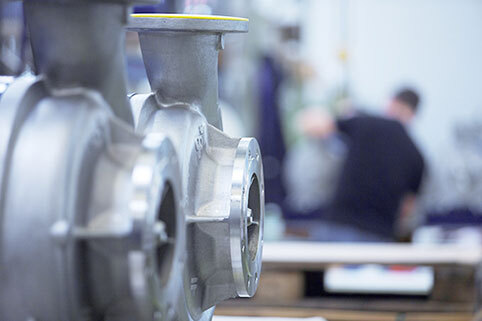CP Pumpen is Specialised in Pumping Difficult Liquids

We were lucky to be able to visit the CP Pumpen factory just before the corona virus was contained. The family business is based in Zofingen, Switzerland, right in the centre of the triangle formed by Zurich, Mulhouse and Bern, about 50 kilometres from each of these three cities.
The first thing you notice when you arrive at this factory is its absolute cleanliness. About 70 people manufacture about 1,500 pumps per year, with a degree of care rarely seen before.
On a tour of the workshops, you will first discover a large machine park that seems almost too big compared to what you might expect. Then we are told that the company machines almost 100 % of the pump components itself, including its own magnetic drives!
Then we are taken on a humorous tour of the spare parts warehouse, here called "Fort Knox". Raw and machined parts are stored in perfect order throughout the basement and are ready for assembly. The production strategy of CP Pumpen is as follows: All pumps are designed as modular as possible and can be assembled as quickly as possible. This enables the company to process more than 99 % of the components of the best-selling ranges and then keep them in stock. "Then we wait for customer orders, and we can assemble, test and ship the pumps in record time," explains Emmanuel Pouffier, sales representative for France, and continues: "Most of the pump bodies and impellers are there, ready for assembly.
As for the assembly of the pumps, it is done in the traditional way, with almost watchmaking care. "This is what makes the Made in Switzerland!", confirms our interlocutor .
CP Pumpen has specialised in the design and manufacture of magnetically driven centrifugal pumps for the safe transfer of up to 1,300 m³/h of pollutants. These pumps, well known in the chemical, petrochemical and pharmaceutical industries, are mainly used for liquids such as solvents, acids, alkalis, but also for very specific liquids such as bromine and sulphur. In fact, the manufacturer assures that with the MKP (magnetic drive pump) series, equipped with the famous magnetic reverse drive, which is unique in the world for its compactness and good internal heat distribution, it is becoming one of the world's leading manufacturers of sulphur pumps.
The magnets that drive them are located inside the pump body. This design is ideal for pumping sulphur. Another advantage is the speed of assembly/disassembly: 20 minutes is enough according to the manufacturer; maintenance departments appreciate this! The MKP is a single-stage standard pump made of stainless steel for flow rates up to 1,300 m³/h. Thanks to its large internal flow channels, it can transfer media with up to 30% solids content with a particle size of up to 1 mm. Of course it is also available in an Atex version, but not only that: in its hygienic BIO version, specially designed for sterile processes, it can be 100 % emptied, can be cleaned or sterilized on site and has numerous approvals from the pharmaceutical industry.
The other flagship of the brand is certainly the MKPL, L as in Lined, i.e. the series of PFA-lined, shielded pumps for flow rates up to 400 m³/h. Here too, the manufacturer has not half-heartedly focused on reliability. To ensure the suitability of these pumps for use in vacuum processes, he has machined workpieces coated with PFA. When the inside of a pump is under vacuum, the PFA literally sticks to the wall, and the pump proves to be much more reliable at operating temperatures from -20 to +200 °C.
The range is completed mainly by self-priming pumps with PFA or metal lining and pumps with ceramic or PFA double seals. Finally, the manufacturer adds that it is gradually implementing a zero waste policy: its pumps are mainly metal and their parts will be fully repairable or recyclable in the near future.
A real difference, according to CP Pumpen, compared to plastic pumps, which are often only used once.
In France, this manufacturer sells about 150 pumps per year, all for very difficult applications. His references include the biggest names in the chemical and pharmaceutical industries.

